Photography Forum
8/3/2017
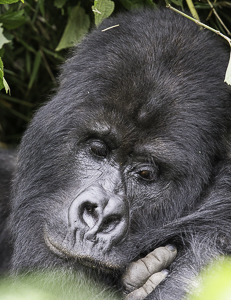
Photographing Gorillas
While it may sound obvious that photographing gorillas is quite different from photographing savanna wildlife, it is not until one is in the rainforest, 10 feet away from a 500lb silverback that you realize just how different the requirements are. As you only have one hour in which to take photos, it's important to arrive with a solid game plan.
Carry In, Carry Out
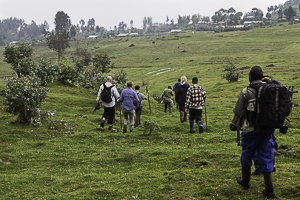 After you have been allocated your gorilla family at Park HQ, your driver will deliver you to the trailhead from where you proceed with your guide and Park scouts, on foot, along narrow mountain trails, slippery with mud and overgrown with brush. Be smart and hire a porter for $10 (+ $10 tip), it helps the local economy and conservation efforts also. Pack all your gear in a waterproof camera bag (preferably backpack). As you get close to the gorilla family, your guide will call a halt for final preparations, at which point you take your gear out of the bag and carry it with you for the next hour: Blackrapid RS sports camera straps are perfect for this purpose.
After you have been allocated your gorilla family at Park HQ, your driver will deliver you to the trailhead from where you proceed with your guide and Park scouts, on foot, along narrow mountain trails, slippery with mud and overgrown with brush. Be smart and hire a porter for $10 (+ $10 tip), it helps the local economy and conservation efforts also. Pack all your gear in a waterproof camera bag (preferably backpack). As you get close to the gorilla family, your guide will call a halt for final preparations, at which point you take your gear out of the bag and carry it with you for the next hour: Blackrapid RS sports camera straps are perfect for this purpose.
Close Quarters
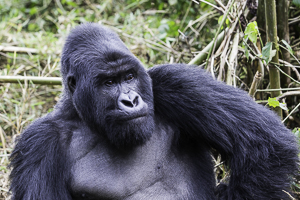
In theory, trekkers are not supposed to approach to within less than 23 feet of gorillas but, in practice, much of your time will be spent closer than this (as long as the gorillas are relaxed and approach you, the guides will not intervene). Long lenses are not only unnecessary, they would be a major handicap. Due to low light conditions, a camera body with full frame sensor is ideal. The perfect arrangement is two camera bodies with full-frame sensors, one mounted with a 70-200mm F/2.8 lens, and the other with a 24-70mm f/2.8 lens (or similar). If you have to choose just one lens, the 70-200mm (or similar) is best. Given the extreme close range, even "point and shoot" cameras will deliver surprisingly good images.
Don't Flash the Gorillas!
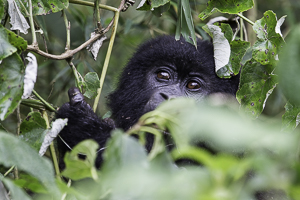 Flash photography is strictly forbidden - please make sure your camera's automatic flash is disabled before your trek. A tripod/monopod is an unnecessary encumbrance given the lightweight camera/lens combinations recommended. Also, thick underbrush snags on tripod/monopod legs, and places a premium on maneuverability - you need to continually move and bend to find openings in the vegetation through which to capture images of the gorillas, and anything that limits quick mobility is a disadvantage.
Flash photography is strictly forbidden - please make sure your camera's automatic flash is disabled before your trek. A tripod/monopod is an unnecessary encumbrance given the lightweight camera/lens combinations recommended. Also, thick underbrush snags on tripod/monopod legs, and places a premium on maneuverability - you need to continually move and bend to find openings in the vegetation through which to capture images of the gorillas, and anything that limits quick mobility is a disadvantage.
Keep Your Powder Dry
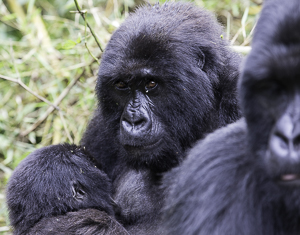
Even during the "dry season", it can rain in the rainforest. As noted above, a waterproof camera bag ie essential for transporting your gear to/from the gorillas. While you are photographing the gorillas, have a Vortex Media Storm Jacket readily available for each camera/lens you're carrying - these small, waterproof camera covers fold up small, weigh nothing, and can be deployed in a jiffy if the heavens suddenly open. Have at least one lens cloth handy, preferably more, for wiping moisture from lenses and view finders.
Rumble in the Jungle
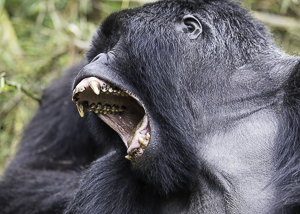 Move around, respectfully. Each stopping point typically presents several gorillas to photograph, all obscured to varying degrees by foliage. Slowly and quietly move between vantage points to capture different subjects and different perspective - be sensitive not to disturb the gorillas or obstruct your fellow trekkers. Select your camera's smallest focusing point (e.g. single point spot AF) so that you can focus between branches, on the subject's face; if you select a larger focusing area, the abundant foliage will trick your camera's auto-focus system, and you'll get blurry shots. Set your lens to a wide aperture to let in as much light as possible while retaining sufficient depth of field to capture facial details.
Move around, respectfully. Each stopping point typically presents several gorillas to photograph, all obscured to varying degrees by foliage. Slowly and quietly move between vantage points to capture different subjects and different perspective - be sensitive not to disturb the gorillas or obstruct your fellow trekkers. Select your camera's smallest focusing point (e.g. single point spot AF) so that you can focus between branches, on the subject's face; if you select a larger focusing area, the abundant foliage will trick your camera's auto-focus system, and you'll get blurry shots. Set your lens to a wide aperture to let in as much light as possible while retaining sufficient depth of field to capture facial details.
STOP AND OBSERVE. Put down the cameras for at least 15 minutes and take in the full sensory experience - sights, sounds, and smells - of one of the most unique wildlife experiences on earth.
Click Here for more photos from Pierre's recent trip to Rwanda.
8/3/2017
Readers' Submissions
«
previous
8/3/2017
Recipe of the Quarter - Breakfast Seed Bars
next »
 |
|  |
|  Share
Share


